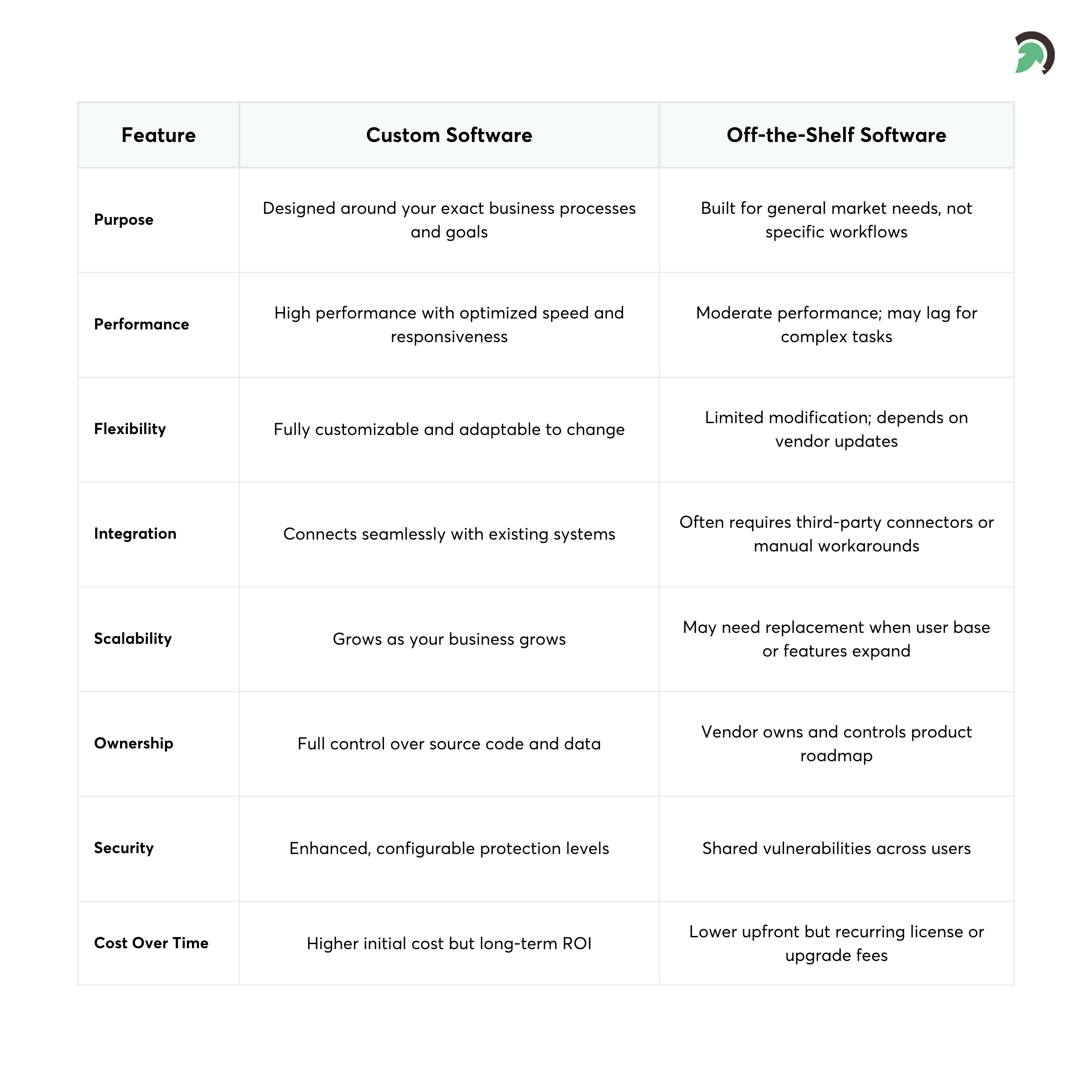Building software from scratch can sound overwhelming at first. Yet, for many organizations, it’s the smartest way to achieve true efficiency and long-term scalability. Off-the-shelf systems might work temporarily, but they often limit flexibility, customization, and control.
This guide explains how to create software that fits your business like a glove, designed for your processes, your people, and your future. You will learn every stage of development, from planning to launch, through a practical and structured lens that even non-technical leaders can understand.
Quick Stat:
As per a report from Grand View Research, the global custom software development market was valued at USD 43.16 billion in 2024 and is projected to surge to USD 146.18 billion by 2030, registering a CAGR of 22.6% from 2025 to 2030.
Why Custom Software Is Worth the Investment
Every company operates differently, and that difference is exactly where competitive advantage lies. Custom software allows your technology to adapt to your unique workflows rather than forcing your team to adjust to generic systems.
For growing organizations, developing custom software brings several hidden advantages. It enhances operational accuracy, automates repetitive tasks, and consolidates information across teams. Small businesses use it to reduce manual effort, while enterprises rely on it to integrate departments, manage data flow, and streamline analytics.
When you develop custom software, you’re not merely creating another application; you’re building a strategic asset. You’re designing an ecosystem that evolves alongside your company, shaped by your goals, customers, and culture.
Step 1: Define Your Vision for Custom Software Development
The foundation of every successful software project is clarity. Before writing a single line of code, you must define what the software will achieve and why it matters.
Start by identifying challenges in your current operations. Maybe your sales team struggles with outdated spreadsheets or your departments rely on disconnected systems that create delays. Understanding these gaps helps you shape clear development goals.
Key actions to take:
- Identify the core problems you want the software to solve.
- Define who will use the system and what features they need most.
- Document must-have functionalities, integrations, and performance expectations.
- Prioritize features based on business impact and feasibility.
At this point, many companies collaborate with a trusted software development company. Their experience helps refine specifications, estimate timelines, and plan budgets. The goal is to move from a concept to a precise, actionable product roadmap.
Step 2: Plan Scalable Software Architecture and Design for Users
With your vision defined, it’s time to create a structure that blends functionality with usability. Architecture determines how your software will work behind the scenes, while design shapes how users will interact with it.
Architecture considerations:
- Choose the right technology stack and frameworks.
- Plan your database structure and API interactions.
- Ensure scalability, security, and performance from the start.
While planning your architecture, it’s valuable to align with the latest innovations. Staying updated with software development trends and emerging technologies ensures your product is built on scalable, future-ready foundations.
Design priorities:
- Focus on a clean, intuitive interface that minimizes learning curves.
- Create wireframes or prototypes to visualize workflows early.
- Align design elements with your brand’s identity and accessibility standards.
By balancing technical architecture and user experience, you lay the groundwork for software that’s both powerful and enjoyable to use.
Step 3: Follow Agile Software Development Best Practices
Now comes the hands-on phase of turning your plan into working software. The best approach is to develop in small, testable cycles using Agile methodology. Each cycle, or “sprint,” focuses on a few features that can be reviewed and improved before moving on.
Best practices for smooth development:
- Use Agile or Scrum frameworks for flexible, incremental progress.
- Maintain version control through platforms like Git for transparency.
- Conduct regular code reviews to ensure quality and consistency.
- Keep detailed documentation to support maintenance and onboarding.Open communication between developers, designers, and business stakeholders is vital.
- Frequent feedback sessions prevent misunderstandings and align every sprint with your real-world needs.
Step 4: Test, Refine, and Ensure Quality
Even well-written code requires rigorous testing before it’s ready for real users. Testing verifies that the system performs reliably, securely, and efficiently.
Types of testing you should include:
- Unit testing: Checks small code components for correct behavior.
- Integration testing: Ensures different modules interact properly.
- Performance testing: Evaluates responsiveness under load.
- Security testing: Detects vulnerabilities before exploitation.
- User acceptance testing: Gathers real user feedback before launch.
Step 5: Deploy Strategically and Train Your Team
After thorough testing, deployment makes your software operational. However, rushing this phase can cause unnecessary disruption. A phased, well-managed rollout reduces risks and prepares teams for transition.
Deployment essentials:
- Prepare production environments, servers, and databases.
- Migrate data safely with minimal downtime.
- Launch gradually by starting with small groups or pilot users.
- Monitor performance closely after going live.
Training tips:
- Conduct workshops or online sessions to onboard users.
- Provide quick reference guides and support resources.
- Encourage feedback from employees to fine-tune usability.
Step 6: Continuous Software Maintenance and Optimization
Once the software is live, continuous maintenance ensures it stays secure, efficient, and relevant. Technology changes fast, and ongoing optimization keeps your system ahead of those shifts.
Key maintenance priorities:
- Continuously roll out updates to resolve issues and boost overall performance.
- Introduce new functionalities guided by user insights and changing requirements.
- Perform routine security reviews and implement patches without delay.
- Evaluate user behavior and system data to uncover opportunities for optimization.
Partnering with a software development company that offers post-launch support ensures your system evolves with your business. Maintenance isn’t an expense; it’s a safeguard that protects your investment and keeps your digital infrastructure strong.
Top 5 Custom Software Development Methodologies Explained
Choosing the right methodology is crucial when you decide to develop custom software. The process you follow affects quality, speed, flexibility, and how well your team adapts to change.
Below is a more detailed look at each methodology, how it fits into the software development process, and when it’s ideal for your project.
1. Agile / Scrum
This is probably the most common methodology used in custom software development services today. In Agile (and especially Scrum), development is broken into short cycles called “sprints,” typically lasting one to four weeks.
Why choose Agile / Scrum?
- You get regular feedback and can adjust scope along the way.
- Stakeholders see working versions early and often.
- You reduce risk of building the wrong features.
Considerations and challenges:
- Scope creep can sneak in if priorities shift without control.
- Requires frequent, clear communication between developers, business teams, and stakeholders.
- You may need experienced Scrum Masters or Agile coaches to guide the process.
Agile is especially good when your requirements are evolving, or when you’re developing software whose features may change midstream.
2. Kanban
Kanban is a visual methodology that is less prescriptive than Scrum. It focuses on continuous flow of tasks, limiting work in progress (WIP), and eliminating bottlenecks.
Why choose Kanban?
- Excellent for maintenance, support, or projects with overlapping requests.
- You keep a visible board of tasks and continuously pull new work when capacity is available.
- It helps teams identify and resolve bottlenecks quickly.
Considerations and challenges:
- Without sprint structure, long-term planning can become vague.
- Delivery predictability is lower compared to Scrum.
- Teams might struggle if they lack discipline and prioritization.
Kanban shines in environments where new requests come frequently or the project is in maintenance mode.
3. Waterfall (Classic SDLC)
Waterfall is the traditional linear model of software development: you complete one phase fully (requirements, design, implementation, testing, deployment) before moving to the next.
Why choose Waterfall?
- Clear, well-defined phases make planning easier.
- Good when requirements are stable and well understood.
- Easier to track progress using phase gates and milestones.
Considerations and challenges:
- Changes late in the process become expensive and disruptive.
- You don’t see working software until late in the cycle.
- It’s rigid and less adaptable to evolving business needs.
Waterfall can still suit projects with low uncertainty, regulatory constraints, or fixed scopes that aren’t likely to change.
4. Lean Development
Client value is the central focus of the lean approach, guiding every decision and process. If an activity adds genuine value, it should be completed immediately; if it does not, it should be removed.
Lean software development places strong emphasis on reducing waste throughout the entire process. Each project is thoroughly analyzed beforehand to prevent unnecessary use of time or resources. Because value remains the core principle, ongoing feedback is essential to ensure quick and effective adjustments.
Why choose Lean?
- Perfect for early stage or MVP development (focus on essential features).
- You validate assumptions early, reducing the risk of building unwanted features.
- Iterative learning is central: launch, measure, learn, adapt.
Considerations and challenges:
- The architecture or long-term quality may suffer if you cut too many corners.
- Requires disciplined balance between speed and stability.
- You will need to refactor frequently as the product scales.
- Lean is ideal when you’re not fully sure of the market or customer needs and want to validate quickly.
5. DevOps / Continuous Delivery
While not a methodology in pure development terms, DevOps is more of a culture and methodology for deployment, operations, and integration with development. The idea is to merge development and operations so that you can release changes quickly, reliably, and continuously.
Why choose DevOps / Continuous Delivery?
- Automation enables faster, safer deployments.
- You reduce the “release pain” of big launches.
- It forces you to think about deployment, monitoring, and feedback early.
Considerations and challenges:
- Needs strong tooling (CI/CD pipelines, automated tests, infrastructure as code).
- Cultural changes are required—teams must collaborate more closely.
- Monitoring, logging, and rollback strategies must be well thought out.
- DevOps is ideal when a product will evolve rapidly or needs frequent updates and high availability.
When to Use Which Methodology?
There is no one-size-fits-all methodology. The decision depends on:
- Project complexity and clarity: If requirements are well-defined, the Waterfall model may be suitable. If they will evolve, go Agile.
- Rate of change: High-change environments benefit from Agile, Lean, or DevOps.
- Team size and maturity: Small teams with experienced developers work well with Agile or Lean. Junior teams may prefer Waterfall initially.
- Deployment frequency: If you plan frequent releases, DevOps/Continuous Delivery is almost necessary.
- Maintenance vs new build: For long-term support, Kanban or DevOps might be better than heavy Sprint cycles.
Why Businesses Need Custom Software Development Solution
Every business operates differently. While ready-made software offers quick deployment, it rarely aligns with unique workflows or long-term goals. As companies scale, generic tools create inefficiencies, compatibility challenges, and restrictions on data ownership.
That’s why many organizations invest in custom software development services to create systems that perfectly match their vision, process, and performance expectations.
Key reasons why businesses choose custom development include:
- Tailored Functionality: Custom systems are built to address your exact requirements, eliminating unnecessary features.
- Scalability and Growth: The architecture adapts as your operations expand or new markets emerge.
- Smooth Integration: Connect effortlessly with existing CRMs, ERPs, or APIs to unify workflows.
- Advanced Security: Proprietary code and encryption reduce risks from public vulnerabilities.
- Competitive Differentiation: Owning unique technology strengthens brand identity and innovation potential.
Below is a quick comparison illustrating how custom and off-the-shelf software differ in practicality and long-term value:

Avoiding Common Pitfalls
Custom development is one of the most rewarding investments a business can make, but it demands careful discipline and consistent alignment. Without it, even the best ideas can lose direction mid-project.
- Guard against scope creep : As development progresses, it’s easy to add “just one more feature.” However, every addition impacts time, cost,and quality. Define clear priorities at the start and use sprint reviews or milestone checkpoints to re-evaluate before expanding scope.
- Prioritize communication early and often : Miscommunication between business teams and developers is one of the top causes of delays and rework. Set up structured communication such as weekly syncs, sprint reviews, and shared project dashboards to keep everyone aligned on goals, progress, and blockers.
- Integrate QA from day one: Testing isn’t a phase; it’s a mindset. Embedding quality assurance throughout development rather than leaving it for the end ensures fewer bugs, smoother integrations, and a more stable product at launch.
When teams stay aligned, manage scope deliberately, and treat testing as continuous improvement, custom software becomes not only easier to build but also stronger, safer, and more scalable for years to come.
Final Thoughts
Creating custom software from scratch is both an art and a process. It blends creativity with structure, vision with precision, and innovation with discipline.
By following software development best practices that include identifying needs, designing with intent, developing iteratively, testing rigorously, and maintaining continuously, you create software that adapts to your business instead of forcing your business to adapt to it.
Whether you’re a startup improving efficiency or an enterprise streamlining data flow, custom development offers the control, flexibility, and scalability needed for long-term growth. It is the foundation for digital independence, empowering your business to innovate without limits.
At EvinceDev, we specialize in building scalable, AI-driven software solutions tailored to business goals. Talk to our experts and get a roadmap designed specifically for your vision.




